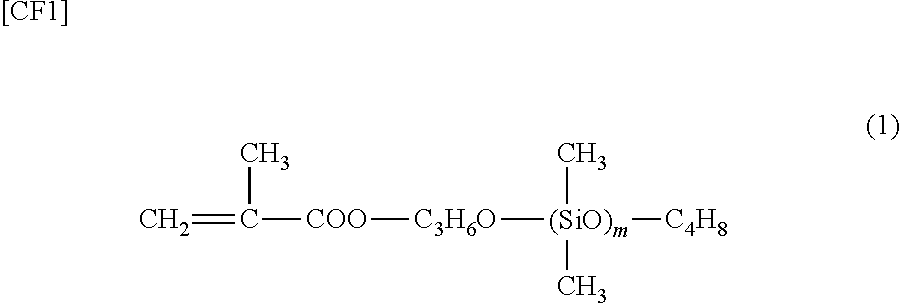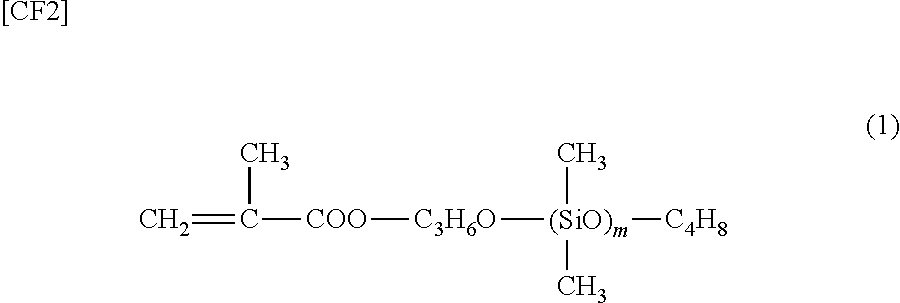Surface property improving agent for molded bodies made of polyolefin resins, resin composition containing the same, and resin molded body made thereof
- Summary
- Abstract
- Description
- Claims
- Application Information
AI Technical Summary
Benefits of technology
Problems solved by technology
Method used
Image
Examples
example 1-1-1-1
[0048]Into a reaction vessel with a volume of 0.5 L, 50.0 g of a microcrystalline wax (a melting point of 69.7° C.) as a non-polar wax (A), 18.0 g of styrene as a monomer (b1), 27.0 g of acrylonitrile, and 1.0 g of methacryloxypropyl polydimethylsiloxane (a number-average molecular weight Mn of 5,000) as a monomer (b2) were charged and 280 g of water, 1.6 g of calcium tertiary phosphate as a dispersant, 0.4 g of hydroxypropylmethyl cellulose, and 0.02 g of an α-methylstyrene dimer as a molecular weight modifier were also charged, followed by heating at 70° C. and stirring for 30 minutes.
[0049]Subsequently, 1.9 g of styrene as a monomer (b1), 3.0 g of acrylonitrile, and 0.66 g of di(3,5,5-trimethylhexanoyl)peroxide as a radical polymerization initiator were mixed together and were charged into the reaction vessel, followed by stirring and reaction at 70° C. for 3 hours. Next, 0.1 g of potassium persulfate as a radical polymerization initiator was dissolved in 0.5 g of water and was c...
examples 1-1-1-2 to 1-1-4-7
and Comparative Examples 1-1-1-1 to 1-1-1-4
[0050]Surface property-improving agents of Examples 1-1-1-2 to 1-1-4-7 and Comparative Examples 1-1-1-1 to 1-1-1-4 were obtained by performing substantially the same operation as that described in Example 1-1-1-1 except that the amounts of the blended non-polar wax (A), monomer (b1), and monomer (b2) were varied as shown in Tables 1 to 4.
[0051]Incidentally, abbreviations used in Tables 1 to 4 represent components below.
MCW: microcrystalline wax (a melting point of 69.7° C.)
PW: paraffin wax (a melting point of 69° C.)
St: styrene monomer
AN: acrylonitrile
PDMS: methacryloxypropyl polyorganosiloxane
[0052]In Tables 1 and 3, the number-average molecular weight (Mn) of PDMS, which represents the monomer (b2), is 5,000. On the other hand, in Tables 2 and 4, the number-average molecular weight (Mn) of PDMS 1, which represents the monomer (b2), is 5,000 and the number-average molecular weight (Mn) of PDMS 2 is 10,000.
TABLE 1Composition of surface prop...
example 1-2-1-1
[0053]Into a reaction vessel with a volume of 0.5 L, 21.6 g of styrene as a monomer (b1), 5.4 g of acrylonitrile, and 1.0 g of methacryloxypropyl polydimethylsiloxane as a monomer (b2) were charged and 280 g of water, 1.6 g of calcium tertiary phosphate as a dispersant, 0.4 g of hydroxypropylmethyl cellulose, and 0.02 g of an α-methylstyrene dimer as a molecular weight modifier were also charged, followed by heating at 70° C. and stirring for 30 minutes.
[0054]Subsequently, 2.4 g of styrene as a monomer (b1), 0.6 g of acrylonitrile, and 0.66 g of di(3,5,5-trimethylhexanoyl)peroxide as a radical polymerization initiator were mixed together and were charged into the reaction vessel, followed by stirring and reaction at 70° C. for 3 hours. Next, 0.1 g of potassium persulfate as a radical polymerization initiator was dissolved in 0.5 g of water and was charged into the reaction vessel, followed by stirring and reaction at 70° C. for 1 hour. Thereafter, cooling to 40° C. or lower, filtrat...
PUM
| Property | Measurement | Unit |
|---|---|---|
| Temperature | aaaaa | aaaaa |
| Temperature | aaaaa | aaaaa |
| Fraction | aaaaa | aaaaa |
Abstract
Description
Claims
Application Information
 Login to View More
Login to View More - R&D
- Intellectual Property
- Life Sciences
- Materials
- Tech Scout
- Unparalleled Data Quality
- Higher Quality Content
- 60% Fewer Hallucinations
Browse by: Latest US Patents, China's latest patents, Technical Efficacy Thesaurus, Application Domain, Technology Topic, Popular Technical Reports.
© 2025 PatSnap. All rights reserved.Legal|Privacy policy|Modern Slavery Act Transparency Statement|Sitemap|About US| Contact US: help@patsnap.com



